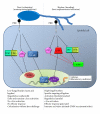Mucosal immunity and Candida albicans infection
- PMID: 21776285
- PMCID: PMC3137974
- DOI: 10.1155/2011/346307
Mucosal immunity and Candida albicans infection
Abstract
Interactions between mucosal surfaces and microbial microbiota are key to host defense, health, and disease. These surfaces are exposed to high numbers of microbes and must be capable of distinguishing between those that are beneficial or avirulent and those that will invade and cause disease. Our understanding of the mechanisms involved in these discriminatory processes has recently begun to expand as new studies bring to light the importance of epithelial cells and novel immune cell subsets such as T(h)17 T cells in these processes. Elucidating how these mechanisms function will improve our understanding of many diverse diseases and improve our ability to treat patients suffering from these conditions. In our voyage to discover these mechanisms, mucosal interactions with opportunistic commensal organisms such as the fungus Candida albicans provide insights that are invaluable. Here, we review current knowledge of the interactions between C. albicans and epithelial surfaces and how this may shape our understanding of microbial-mucosal interactions.
Figures


References
-
- Sobel JD. Pathogenesis and epidemiology of vulvovaginal candidiasis. Annals of the New York Academy of Sciences. 1988;544:547–557. - PubMed
-
- Sobel JD. Pathogenesis and treatment of recurrent vulvovaginal candidiasis. Clinical Infectious Diseases. 1992;14(supplement 1):S148–S153. - PubMed
-
- Palmer GD, Robinson PG, Challacombe SJ, et al. Aetiological factors for oral manifestations of HIV. Oral Diseases. 1996;2(3):193–197. - PubMed
-
- Phelan JA, Saltzman BR, Friedland GH, Klein RS. Oral findings in patients with acquired immunodeficiency syndrome. Oral Surgery, Oral Medicine, Oral Pathology. 1987;64(1):50–56. - PubMed
Publication types
MeSH terms
Substances
LinkOut - more resources
Full Text Sources
Other Literature Sources
Medical

